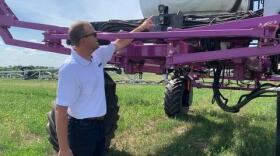East River, West River
East River, West River
East River, West River: With farming in the east and ranching in the west, South Dakota has always had a split personality. The East River area is more like the eastern United States, and the West River is more like the Wild West. Even the weather changes from east to west. More rain in the east makes raising crops easier. Less rain in the west makes raising cattle more common. This program looks at the history of the state and how the East River and West River split has affected the growth of the state.
Related Resources
Additional videos, activities, and more are below.
YouTube Playlist with a variety episode related topics including old barns across South Dakota.
Learn about the world’s only Corn Palace and complete an activity where your students will create or recreate a Corn Palace mural using tissue paper.
The South Dakota Historical Society looks at the history of the first bridge across the Missouri River in the state at Mobridge.
A simple density activity that shows items can sink or float in materials other than water.
This archival video shows the steps in milk processing from intake through bottling.
Students will learn about the iron lung medical device which was used to treat many polio patients.
South Dakota is an ideal place for honeybees, but conditions make it difficult. (Image - Deep Creek Honey)
Historically, the 100th meridian marked the shift from the wet east to the drier west. Now that's changing.
Rural electrification changed life on farms, especially those involved in dairy and poultry production.
A list of fire lookouts: some active, open to the public, and closed, and how to get there, and what you'll see.
There’s something different about this tractor. The cab is empty.
The number of bear sightings is up
View examples of Harvey Dunn's prairie paintings, then create a local landscape painting to display in the classroom.
A historical look at sugar and wool production, ranching, the Orman Dam, and more.
Students will participate in an activity exploring their 5 senses, including touch, smell, hearing, sight, and taste.
Black Hills Sawmills: popping up in Rockerville, Rapid City, Deadwood, Hill City, and Hot Springs
A rush of European and other settlers hoping for a fresh start entered Dakota territory after the Civil War.
Most farmers grow and sell commodity crops but a Brown Co. farmer decided to cut out the middleman.
Turkeys were placed in wood, concrete, and earth barns. Those surviving winter were in a rammed earth building.
Most round barns were built in the East River area.
A house nestled in the Missouri River bluffs is Clay County's oldest dwelling.
The livestock trade was highly significant in the growth of Sioux Falls and neighboring communities.
Officials resisted legalizing hemp. That changed when a bill was signed authorizing production of the crop.
For more information about
SDPB's educational resources and services,
contact Steven Rokusek at [email protected]
(605)222-3422
Set by the SD Board of Education
Additional Resources


























